Abstract
Physical therapy represents a very important factor in the recovery of shoulder trauma for performance handball players. Performing a prophylactic program of exercises or practicing physical therapy for rehabilitation after a lesion, can improve general health and parameters as muscular strength, range of motion, quality of life or pain. Scientific literature proves the need of further studies regarding rehabilitation of shoulder trauma in sports that involve overhead throwing, such as handball. For this paper we conducted research for 25 performance handball players which followed specific recovery exercises, and conducted initial and final tests to observe if physical therapy is efficient for recovery of shoulder trauma. After comparing the results, we observed significant improvement of range of motion, muscular strength, blood circulation, pretension, functional parameters, quality of life and decrease of pain. Through this study we proved that physical therapy improves significantly all the parameters a handball player needs to improve in order to benefit of a faster and more efficient recovery from trauma.
Keywords: Leisure, preschool, personality, sports
Introduction
Achieving performance in the game of handball requires high-intensity physical effort, and rigorous training, which leads to the above average demand of the human body, and specific adaptations to the conditions of performance sports (Andersson et al., 2018).
Scientific papers highlighted the need to further studies in order to identify the mechanism of injuries, risk factors (Tooth et al., 2020) and means of rehabilitation for shoulder trauma in handball and other overhead throwing sports (Zaremski et al., 2019). It is needed to determine even if specific adaptation for overhead throwing athletes lead to increased possibility of injury (Keller et al., 2018). In order to identify and diagnose shoulder pathology, a systematic knowledge of bony, ligamentous and neuromuscular anatomy is required (Bakhsh & Nicandri, 2018). Immaturity of the musculoskeletal system can be associated to failure of motor skills (De Oliveira et al., 2017).
The functional capacity of the body must be in optimal condition for the proper performance of sports activity, otherwise the systems in the human body may suffer from various pathologies, with increased incidence when it comes to the neuro-myo-arthro-kinetic apparatus (Sbenghe, 1987, p. 405). Studies have shown that shoulder pain is higher for players who perform overhead motions (Mohseni-Bandpei et al., 2012). History and physical examination remain essential to create the differential diagnosis (Cotter et al., 2018) Recent studies have shown that stretching exercises for posterior shoulder improve pain, range of motion and function (Tahran & Yeşilyaprak, 2020).
Physiotherapy aims to preserve and recover the function of the shoulder if it has been affected, in order to eliminate the negative consequences of shoulder injuries in performance handball and to increase the quality of life of the athlete and, implicitly, his level of performance (Fredriksen et al., 2020).
Problem Statement
Physical therapy is a complex means meant to improve general health of performance players, but it can also improve significantly the recovery of a lesion when it comes to shoulder joint. If players would follow a specific prophylactic program of exercises, this would improve their health and also their performance level. This study is meant to prove the efficiency of these exercises by initial and final tests, in order to compare the results and observe the improvement.
Research Questions
The questions we aim to respond by conducting this research are:
Is physical therapy useful for decreasing pain in handball players?
Can physical exercises improve muscular strength and joint mobility?
Do physical exercises improve quality of life for handball players?
How does physical therapy influence functional capacity of shoulder for performance players?
Purpose of the Study
The aim of this study is to ascertain the benefits that a preventive program brings through physiotherapeutic means to performance athletes who play handball. The objectives of this prophylactic program are to improve mobility and muscle strength, increase joint stability, and prepare the player's body to meet the demands of the game of handball.
The main objective of this research is to develop a prophylactic program through physical means aimed at the scapulohumeral joint, in order to reduce the injuries of athletes at this level. Other secondary objectives are to reduce the time of absence of the athlete for medical recovery and to reduce the costs of healthcare in case of injuries. The operational prevention program aims to reduce the incidence of injuries during both competitions and training.
Research Methods
The sample of subjects included in the research is represented by the handball players of the team of the University Club of Suceava, in number of 25. The duration of the study was covered in a whole season, about a year, during which time the initial and final data were collected, which were then interpreted, and following which the conclusions of this research were drawn.
The experimental research took place within the "Interdisciplinary Research Center in Motor and Human Health Sciences", coordinated by prof. dr. Bogdan Grosu, professor at the “Ștefan cel Mare” University of Suceava.
In the first stage, athletes participating in the study were selected, of which 5 are goalkeepers, 6 on the pivot position, 3 play on the center position, 2 for the left inter position and 3 for the right inter position, 4 players for the extreme left and 2 for the far right.
The second stage included the initial evaluations of the athletes, the application of the preventive protocol by physical therapy means, with the permanent monitoring of the evolution of the athletes regarding the parameters targeted in the study.
The third stage included the final evaluation of the athletes, the interpretation of the data thus obtained, and finally, the elaboration of the conclusions of these works.
The functional parameters followed for the experiment were as follows:
The VAS scale, used to assess pain, where 0 represents the absence of pain and 10 its maximum threshold.
The questionnaire of Burckhardt and Anderson for quality of life, which includes items such as material status, social activity, relationships, etc.
Functional balance of the shoulder, according to the authors Constant and Murley (1987), who give a certain score for various activities of the shoulder joint.
Joint amplitude measured for flexion, extension, abduction, adduction, and internal and external rotation of the shoulder by the goniometric method (Sbenghe, 2008).
Muscle strength was assessed using manual testing, for the same movements as in the parameter described above, using the F0-F5 scale (Chiriac, 2000).
The perimeters of the arm and forearm, in order to measure muscle trophic function and muscle tone, using the metric band.
The gripping force was assessed using a spring dynamometer for both upper limbs.
The functional tests that were applied to the shoulder joint were:
Patte test, used for small round and subspinous muscles: the shoulder is placed in 90 ° abduction, the elbow in 90 ° flexion, the athlete tries to perform the external rotational movement against the opposite resistance of the physiotherapist; if pain occurs, one of the two targeted muscles may be affected.
The Jobe test is applied to check the integrity of the supraspinatus muscle; the athlete flexes and abducts the upper limbs at 30 °, with the forearm in pronation, then tries to resist the pressure of the physiotherapist to bring the arms closer to the torso; the presence of pain may indicate antero-superior damage to the target area.
The Gerber test is performed to check the condition of the subscapularis muscle; the athlete keeps the elbow bent at 90 °, with the forearm at the back, and the physiotherapist moves the forearm away. If the subject cannot resist the physiotherapist, the subscapularis muscle may be affected (Manole & Manole, 2009).
Content of the prevention and recovery program
The prevention and recovery program included the following techniques:
- Hydrokinetic means: hot showers and hydrokinetic exercises in small water;
- Massage techniques applied around the scapulohumeral joint, with a relaxing and muscle-relaxing role;
- Neuroproprioceptive facilitation techniques: alternating isometry, isometric construction in the shortened area, and slow reversal with opposition. They have been used to promote joint stability.
- Active stretching, with the role of preparing the muscles for the exercise program;
- Exercise, used to increase joint mobility and muscle strength, promote joint stability and motor skills;
- Electrotherapy, which used interference current, TENS current, and ultrasound therapy, having the role of analgesia and increasing muscle trophic function.
Findings
At In order to present the results obtained from the application of the program described above, the values of the initial and final measurements will be analyzed comparatively, for each parameter.
For the pain parameter, the VAS scale was applied, where 0 represents the absence of pain and 10 the maximum pain threshold. The average values recorded for the initial and final testing are as follows:
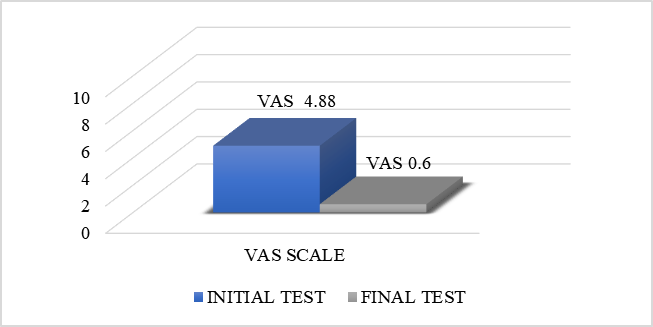
Figure 1 shows the average value of the initial VAS scale parameter much higher than the final average value of the same parameter, which shows the significant decrease in pain following the application of the physical therapy program.
From a statistical point of view, for the pain parameter, the following indices were registered:
The quality of life parameter was assessed using the quality of life questionnaire of Burckhardt and Anderson, which covers leisure time activities, relationships, social work, material conditions, etc. The higher the score, the better the quality of life of the athlete.
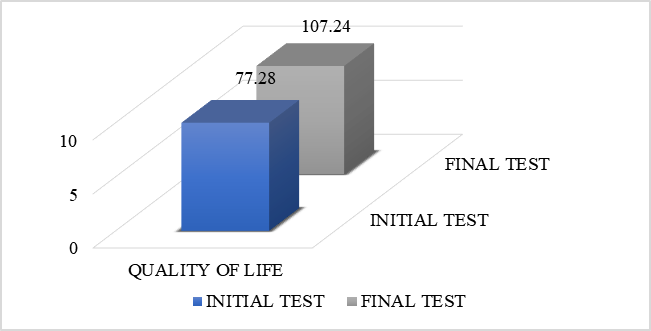
As can be seen in Figure 2, the initial average value obtained for the quality of life parameter is lower than the final average value, which means an increase in the quality of life of the players due to the exercise program.
In the case of quality of life, the values of the statistical indices showed according to the table below:
The functional balance by the method of Constant and Murley appreciates items such as sports activity, self-care activities, housekeeping, sleep, etc. The mean values obtained from the initial and final measurements were:
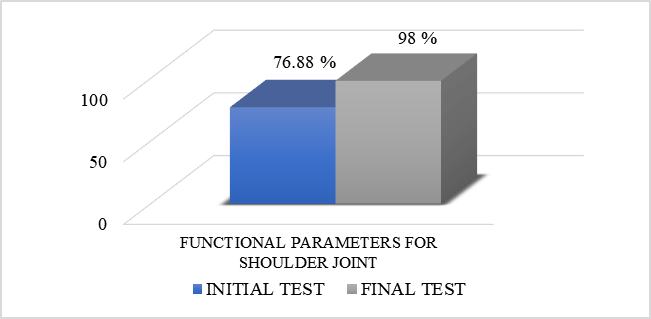
Regarding the functional balance of the shoulder, figure 3 shows a much higher final value than the initial value, which means that the functional parameters of the shoulder have improved due to the application of physical therapy exercises.
For the functional balance of the shoulder, the statistical indices were presented as follows:
As figure 4 shows, for the joint mobility parameter, all the final average values of all the studied movements are significantly increased compared to the initial average values, proving to increase the mobility of the humeral joint.
Joint mobility was tested by the goniometric method for flexion, extension, abduction, internal and external rotation movements. The average values were as follows:
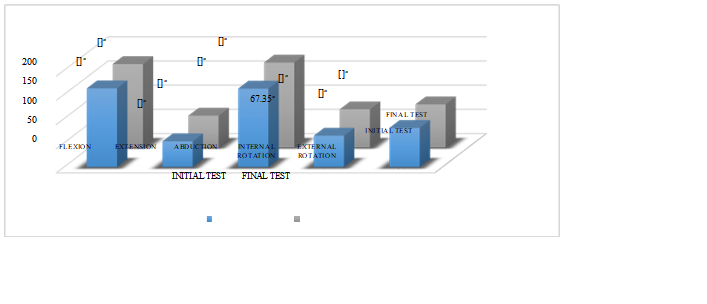
Joint mobility recorded the following values for statistical indices:
Using the manual test method, with values between F0 and F5, where F0 represents the absence of neuromuscular activity and F5 increased muscle strength, the mean values were presented as follows in figure 5:
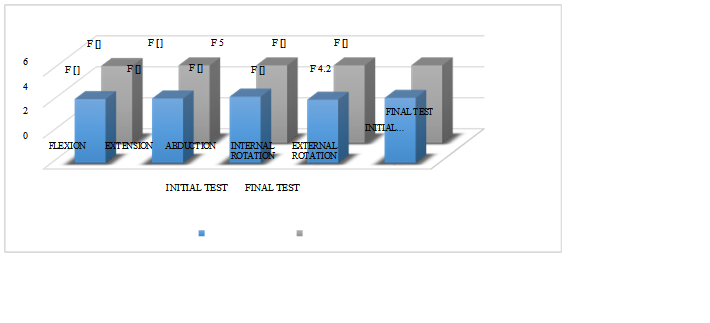
Statistical indices for the muscle strength parameter are obtained as follows:
The perimeter of the arm and forearm was measured to assess the degree of trophic function, muscle toning, or swelling of the tissues. The average values are illustrated in figure 6, where the initial average values are lower than the final average values. This demonstrates an increase in tissue trophic function for the periarticular muscles of the shoulder.
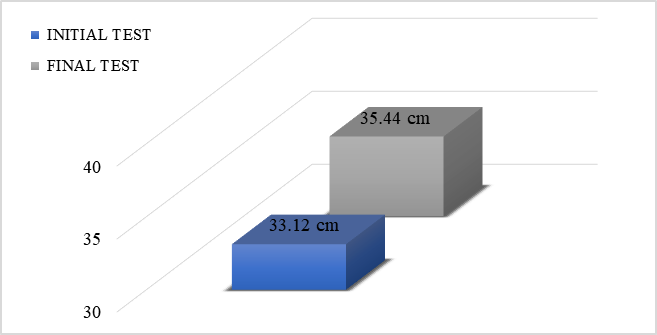
Statistical indices for this parameter are:
Figure 7 shows the same improvement in muscle trophic function observed for the forearm.
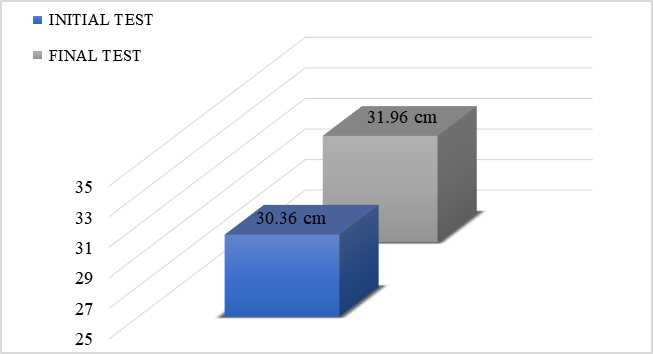
Regarding the statistical indices, for the perimeter of the forearm they are:
The gripping force was measured using the mechanical dynamometer, with spring, in 3 tests, where the maximum value obtained was taken into account for data processing.
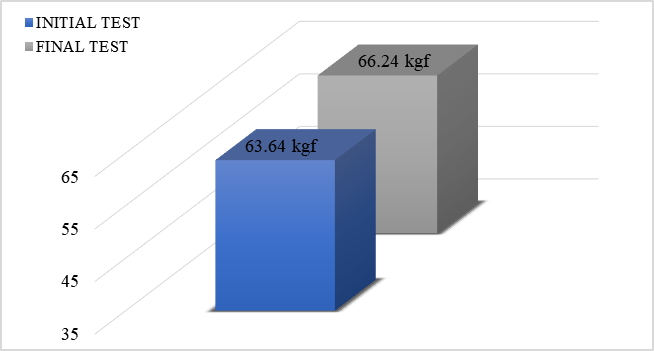
Following the application of the physiotherapy program, the final grasping force is also improved compared to the initial one, as illustrated in Figure 8.
The statistical indices for the gripping force parameter look like this:
Applied functional tests showed a decrease in the frequency of traumatic injuries to the internal rotator cuff and abductor muscles of the shoulder, as shown in the table below, the number of athletes with an initial positive test compared to the number of athletes with a final positive test.
Conclusions
Handball is a complex sport that uses overhead throwing, which can easily lead to lesions of humeral joint. Scientific papers prove that there is a significant improvement of rehabilitation when physical therapy is implemented as a prophylactic measure, and especially as a means of treatment for injury.
The present paper has shown the role of physical therapy for players who practice performance handball, by applying physical means in order to fasten rehabilitation and improve quality of life for players.
Following initial and final tests as illustrated in figures and tables 1-8 and table 9, significantly improved final values were observed for each of the measured parameters: pain, quality of life, functional balance, joint mobility, muscle strength, gripping force and tissue trophic function by measuring the perimeters of the arm and forearm.
These results demonstrate the effectiveness of a physiotherapy prophylaxis program applied to athletes who practice performance handball, but also the important role that physical therapy plays in the recovery of athletes who overcome shoulder injuries.
References
Andersson, S. H., Bahr, R., Clarsen, B., & Myklebust, G. (2018). Risk factors for overuse shoulder injuries in a mixed-sex cohort of 329 elite handball players: previous findings could not be confirmed. British Journal of Sports Medicine, 52(18), 1191-1198. DOI:
Bakhsh, W., & Nicandri, G. (2018). Anatomy and Physical Examination of the Shoulder. Sports Medicine and Arthroscopy Review, 26(3), e10-e22. DOI: 10.1097/jsa.0000000000000202
Chiriac, M. (2000). Testarea manual a forței musculare [Manual testing of muscle strength]. Editor Universitario of Oradea.
Constant, C., & Murley, A. (1987, January). A clinical method of functional assessment of the shoulder. Clinical Orthopedics and Related Research.
Cotter, E. J., Hannon, C. P., Christian, D., Frank, R. M., & Bach, B. R., Jr. (2018). Comprehensive Examination of the Athlete's Shoulder. Sports Health: A Multidisciplinary Approach, 10(4), 366-375. DOI:
Fredriksen, H., Cools, A., Bahr, R., & Myklebust, G. (2020). Does an effective shoulder injury prevention program affect risk factors in handball? A randomized controlled study. Scandinavian Journal of Medicine & Science in Sports, 30(8), 1423-1433. DOI:
Keller, R. A., De Giacomo, A. F., Neumann, J. A., Limpisvasti, O., & Tibone, J. E. (2018). Glenohumeral Internal Rotation Deficit and Risk of Upper Extremity Injury in Overhead Athletes: A Meta-Analysis and Systematic Review. Sports Health: A Multidisciplinary Approach, 10(2), 125-132. DOI: 10.1177/1941738118756577
Manole, V., & Manole, L. (2009). Evaluarea motrică și funcțională în kinetoterapie [Motor and functional assessment in physical therapy]. Editor PIM.
Mohseni-Bandpei, M. A., Keshavarz, R., Minoonejhad, H., Mohsenifar, H., & Shakeri, H. (2012). Shoulder Pain in Iranian Elite Athletes: The Prevalence and Risk Factors. Journal of Manipulative and Physiological Therapeutics, 35(7), 541-548. DOI: 10.1016/j.jmpt.2012.07.011
Oliveira, V. M. A. de, Pitangui, A. C. R., Gomes, M. R. A., Silva, H. A. da, Passos, M. H. P. dos, & Araújo, R. C. de. (2017). Shoulder pain in adolescent athletes: prevalence, associated factors and its influence on upper limb function. Brazilian Journal of Physical Therapy, 21(2), 107-113. DOI:
Sbenghe, T. (1987). Kinesiologie profilactică, terapeutică și de recuperare [Preventive, therapeutic and recovery kinesiology]. Editor Medical.
Sbenghe, T. (2008). Kinesiologie - știința miscării [Kinesiology - the science of movement]. Editor Medical.
Tahran, Ö., & Yeşilyaprak, S. S. (2020). Effects of Modified Posterior Shoulder Stretching Exercises on Shoulder Mobility, Pain, and Dysfunction in Patients with Subacromial Impingement Syndrome. Sports Health: A Multidisciplinary Approach, 12(2), 139-148. DOI:
Tooth, C., Gofflot, A., Schwartz, C., Croisier, J.-L., Beaudart, C., Bruyère, O., & Forthomme, B. (2020). Risk Factors of Overuse Shoulder Injuries in Overhead Athletes: A Systematic Review. Sports Health: A Multidisciplinary Approach, 12(5), 478-487. DOI:
Zaremski, J. L., Zeppieri, G., Jr., & Tripp, B. L. (2019). Sport Specialization and Overuse Injuries in Adolescent Throwing Athletes: A Narrative Review. Journal of Athletic Training, 54(10), 1030-1039. DOI:
Copyright information

This work is licensed under a Creative Commons Attribution-NonCommercial-NoDerivatives 4.0 International License.
About this article
Publication Date
10 April 2023
Article Doi
eBook ISBN
978-1-80296-961-0
Publisher
European Publisher
Volume
5
Print ISBN (optional)
-
Edition Number
1st Edition
Pages
1-1463
Subjects
Education sciences, teacher education, curriculum development, educational policies and management
Cite this article as:
Mihăilă, I., Daniela Corina, P., & Gîtman, R. (2023). The Contribution of Physical Therapy to Handball Shoulder Injuries. In E. Soare, & C. Langa (Eds.), Education Facing Contemporary World Issues - EDU WORLD 2022, vol 5. European Proceedings of Educational Sciences (pp. 999-1009). European Publisher. https://doi.org/10.15405/epes.23045.101

